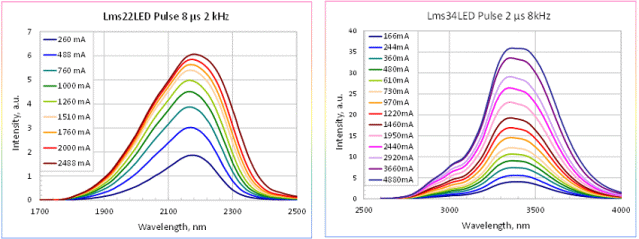LEDs offer numerous benefits due to possibility of different operation modes. Optical parameters of light emitting diodes strongly depend on the operation regime that you choose. There are two main ways to drive LEDs: quasi continuous-wave mode (QCW) and pulse mode.
Quasi Continuous-wave Mode (Quasi-CW)
QCW means that an LED is switched on only for certain time intervals, which are short enough to reduce thermal effects significantly, but still long enough that the LED process is close to steady state. To receive maximum average power we recommend using pulse modes with duty cycle 50% (quasi-continuous wave mode) or 25%. This mode provides signal modulation at certain frequency and allows obtaining higher output intensity than in case of using hard CW (continuous wave) mode. Therefore hard CW is not recommended.
QUASI-CONTINUOUS WAVE (QUASI-CW) MODE:

Spectra at different currents in the quasi-CW mode (frequency 0.5 kHz, duty circle 50%):

Power dependence on current in the quasi-CW mode (frequency 0.5 kHz, duty circle 50%):

Pulse mode
Pulse mode with short pulse time (less than 50 ms) helps obtaining the maximum peak power.
Spectra at different currents in the pulse mode:

Power dependence on current in the pulse mode:

Power dependence on duty cycle (duty cycle = pulse duration/pulse period):


